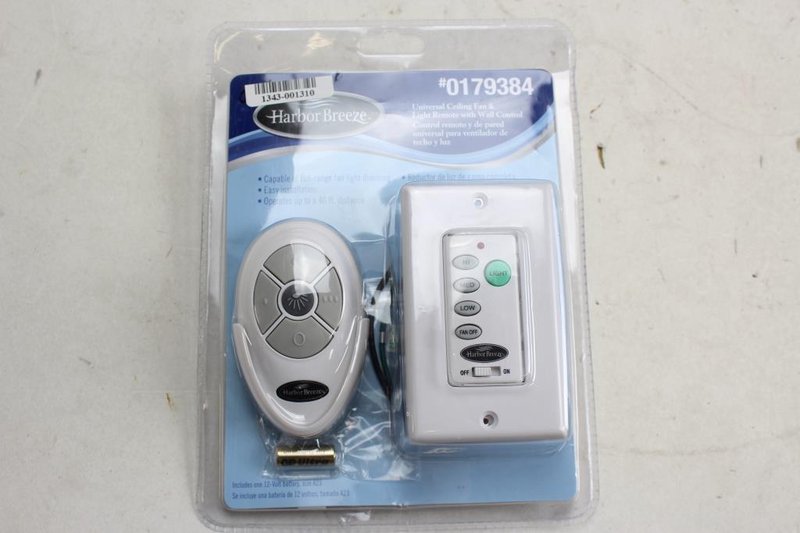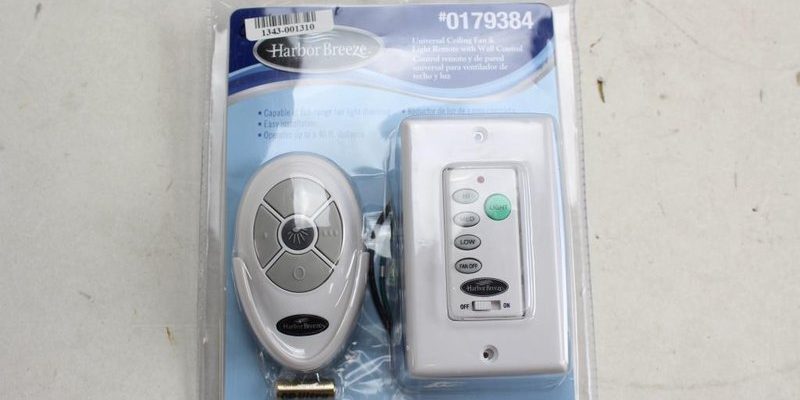
If you’re new to ceiling fan remotes, the whole “receiver” thing can sound a little techy, maybe even intimidating. But let me explain: for a Harbor Breeze remote to work, it needs something inside the fan to pick up its signals. Without that receiver, your remote is basically just a plastic paperweight. It’s like trying to tune an old radio with no antenna — you can press buttons all day long, but nothing will change.
So, let’s break down what you really need to get your Harbor Breeze ceiling fan remote working, why the receiver is essential, and how to spot (and solve) common problems. I promise, you don’t need to be a tech wizard — just a little curiosity and patience.
How Harbor Breeze Ceiling Fan Remotes Communicate
Most people assume that a remote works just because you point it at something and hit a button. With ceiling fans, though, there’s a bit more going on behind the scenes. When you use a Harbor Breeze remote, you’re sending a wireless signal — usually using radio frequency (RF) rather than infrared like a TV remote. The thing is, the ceiling fan doesn’t just “hear” this signal out of thin air.
The receiver is a small box hidden up inside the fan’s canopy (that metal cap up at the ceiling). It’s wired directly into the fan’s power and control circuits. When you press a button on your remote (like turning the light on or changing the fan speed), the remote sends out a code. The receiver up in the ceiling is what actually catches this code and tells the fan what to do.
Here’s the thing: if your Harbor Breeze fan didn’t come with a receiver installed, or if the receiver is faulty or missing, the remote simply won’t work. It’s like texting a friend who forgot their phone at home. No receiver, no response.
You might also notice that sometimes remotes can get “out of sync” or need to be paired with the receiver. This is because both the remote and the receiver have to be matched up — they share a unique code so your neighbor’s remote doesn’t control your fan by accident. It’s all about clear communication, and the receiver makes that possible.
Why a Receiver Is Essential for Harbor Breeze Remotes
Honestly, the receiver is the heart of any Harbor Breeze remote-controlled fan setup. If you’re wondering why you can’t just use the remote without it, think of it like trying to call someone with no phone on their end. The remote is only half the story; the receiver completes the circuit.
Without a receiver:
- Your remote won’t control light or fan speed — no matter how often you press the buttons.
- There’s nothing inside the fan to interpret the wireless signals.
- Troubleshooting becomes impossible — you can swap batteries and reset codes until you’re blue in the face, but there will be no response.
Some newer ceiling fans are “smart” and have built-in receivers. But for most Harbor Breeze models, the receiver is a separate box that comes with the remote kit, or it’s already tucked inside the fan canopy from the factory. If you’re replacing or upgrading your remote, you’ll almost always need to make sure you have a compatible receiver as well.
You might be tempted to skip the receiver if your fan is wired to a wall switch. Here’s the catch: the wall switch just cuts power to the whole fan, it can’t change speeds or dim lights the way a remote and receiver can. So, unless you’re happy with just on/off control, you can’t ditch the receiver.
How to Tell if Your Harbor Breeze Fan Has a Receiver Installed
You might be wondering, “How do I even know if my fan has a receiver?” It’s a fair question, because the receiver isn’t visible from the ground — it’s hidden up in the ceiling canopy where the fan attaches.
Here’s how to check:
- Turn off the power at the breaker for safety.
- Remove the canopy cover at the ceiling. This usually involves a couple of screws.
- Look for a small rectangular (usually black or white) box connected to the fan’s wiring. That’s the receiver.
- The receiver will have wire leads going to the fan, power supply, and sometimes the light kit.
If you see a receiver, congrats! Your fan is ready (or nearly ready) to pair with a Harbor Breeze remote. If not, you’ll need to install one. Keep in mind, not all receivers fit every fan — so double-check that yours is compatible with your exact Harbor Breeze model.
Sometimes, a fan will act “dead” even with a receiver installed. In that case, the receiver might be faulty or the remote needs to be synced (more on that in a bit). But it’s always smart to check for a receiver first before diving into complex troubleshooting.
Pairing and Syncing Your Harbor Breeze Remote and Receiver
Let’s say you’ve got both a remote and a receiver. But, what if pressing buttons still does nothing? That usually means the remote and receiver aren’t “talking” to each other — this is where pairing (or syncing) comes in.
Most Harbor Breeze remotes and receivers use DIP switches (tiny toggle switches hidden under the battery cover of the remote and sometimes on the receiver). Both devices need the switches to match, or else signals won’t get recognized.
Here’s how to pair your Harbor Breeze remote and receiver:
- Open the remote’s battery compartment.
- Find and set the DIP switches to any pattern you like (just be sure both remote and receiver match exactly).
- If your remote doesn’t use DIP switches, there may be a pairing button. Hold it down after reinstalling batteries or powering up the fan.
- Restore power, then test the remote. The fan should respond if paired properly.
Sometimes things get out of sync — maybe the power flickered, or you swapped remotes. In these cases, resetting the receiver (usually by toggling the power or holding a reset button) can help. If your remote has fresh batteries and matching codes, but still won’t work, the receiver is likely the culprit.
Each step is about getting the two halves — remote and receiver — to recognize each other. It’s a bit like matching a new car key fob to your car; both parts need to be “introduced” before they’ll cooperate.
Common Harbor Breeze Remote and Receiver Problems
Ceiling fan remotes seem simple, but when things go wrong, it can feel like chasing ghosts. Let’s walk through some realistic stumbling blocks, and what each probably means for your receiver:
- Remote won’t work at all: Start with the basics — check the battery. If that’s good, the receiver may lack power (breaker issue?) or is faulty.
- Fan responds inconsistently: The receiver might be losing its connection, perhaps from power surges. Try resetting or replacing it.
- Remote only works up close: The receiver’s antenna could be blocked by wiring or crammed inside the canopy. Adjust its position if possible.
- Light works, but fan doesn’t (or vice versa): Receivers sometimes only half-fail. If splits like this happen, a replacement receiver is likely needed.
- Neighbor’s remote controls your fan: The code on the receiver and remote aren’t unique. Change your DIP switch settings and pair again.
Honestly, most issues end up being about battery life, code mismatch, or a worn-out receiver. Receivers usually last years, but aren’t immune to power surges or old age.
Installing or Replacing a Harbor Breeze Ceiling Fan Receiver
If your ceiling fan didn’t come with a receiver — or you need to replace a faulty one — you don’t need to be an electrician, but you should be careful. Think of it like swapping out a part in your car; a bit fiddly but doable if you follow the steps.
Steps for installing a Harbor Breeze receiver:
- Make sure power to the fan is off at the breaker — seriously, don’t skip this.
- Remove the ceiling canopy so you can access the wiring.
- Disconnect the wires leading from the fan. Note which wire goes where (take a photo if needed).
- Connect the new receiver according to its wiring diagram. Typically, it sits between the power source and the fan/light wires.
- Tuck the receiver carefully into the canopy space, ensuring wires aren’t pinched.
- Re-attach the canopy and restore power.
- Pair the remote, set your code, and test operation.
If you’re nervous with electrical work, don’t hesitate to call a pro. But for most people, swapping a receiver is more about patience than technical skill.
Some universal receivers can work with Harbor Breeze remotes, but always check compatibility. Using mismatched parts leads to headaches — and sometimes, nothing at all happens.
Universal vs Harbor Breeze Brand Remote and Receiver Kits
You might be tempted to buy a universal ceiling fan remote kit, especially if the Harbor Breeze kit is out of stock. It’s a bit like putting a non-OEM part into your car: sometimes it works, but not always as smoothly.
Harbor Breeze brand remote/receiver kits are made to match their ceiling fan models exactly. The wiring colors, codes, and functions all align. Universal kits, on the other hand, can fit many brands, but may lack certain features (like reverse or dimming), and sometimes require creative installation.
Advantages of Harbor Breeze brand kits:
- Guaranteed compatibility with most Harbor Breeze fans.
- Full access to all features (fan speed, lights, dimming, etc.).
- Clear troubleshooting with brand-specific support.
Universal kits can work, but you may lose advanced features, or need to rewire certain functions. If your fan model is older, or the original receiver is discontinued, a universal kit might be your best bet — just know what trade-offs might come with it.
Bottom line: Always double-check the compatibility of any remote and receiver kit with your specific Harbor Breeze fan model.
Troubleshooting Tips for Harbor Breeze Remote and Receiver Issues
If everything looks set up, but your fan still isn’t cooperating, let’s walk through some solid troubleshooting steps (before you give up and control your fan with a broom handle):
- Check batteries first. Weak batteries are the simplest fix and the cause of a surprising number of issues.
- Inspect the receiver for loose wires. Power surges or rough installation can loosen connections.
- Reset the remote and receiver. Cut power for a few minutes, restore, and try pairing again.
- Confirm matching codes/DIP switches. Even a single switch out of place means the remote and receiver won’t sync.
- Test range. Walk closer and farther from the fan. If range is inconsistent, try repositioning the receiver’s antenna.
- If all else fails, test with a different remote or receiver. Sometimes, the part you think is fine is actually the problem.
Ceiling fan remotes and receivers are simple, but they don’t forgive rushed work or mismatched components. Most frustrations boil down to missing receivers, battery problems, or code mismatches.
Final Thoughts: Making Harbor Breeze Remote Control Work For You
Getting a Harbor Breeze ceiling fan remote to work isn’t just about the flashy handheld unit. It’s about the partnership between that remote and a receiver tucked out of sight. The receiver is what makes remote magic possible — translating your button presses into real action at the fan.
If you’re just moving in, replacing parts, or troubleshooting, always start by confirming that a receiver is present and properly paired. Don’t get discouraged by a few hiccups; most issues can be solved with a little patience and methodical checking. And remember, there’s no shame in calling in help if wiring isn’t your thing.
With the right setup, your Harbor Breeze fan will respond to your remote every time, making life at home a little breezier — without ever having to reach for a pull chain again.
